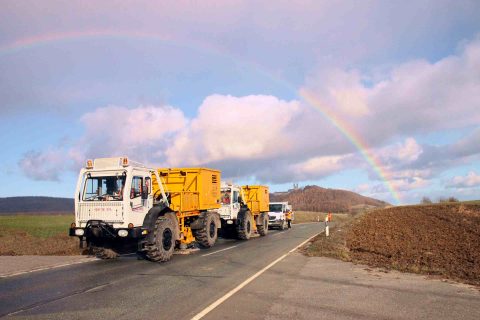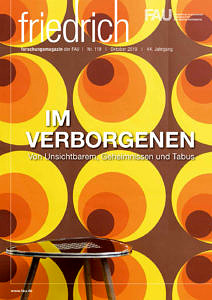Under the earth

When people think about sustainable energy, they rarely have in mind the ground beneath their feet, despite the fact that the heat hidden down below is already used for power generation: For example, two boreholes in Bad Staffelstein near Lichtenfels that go down to depths of 1,600 and 1,180 metres supply salt water at temperatures of 52°C and 53°C for a spa resort and thermal baths. Other baths are fed with warm water at a temperature of 34°C pumped from a depth of 652 metres in Bad Rodach not far from Coburg. Both towns profit here from temperatures in the ground about midway between Coburg and Bamberg which are more than 10°C higher than the average at those depths.
by Roland Knauer
These are ideal conditions for making use of geothermal energy: The shorter the boreholes needed to reach usable temperatures, the cheaper it is. That is why planners naturally want to know as much as possible about the substrate before a town or company starts using geothermal energy: How high are the temperatures really and where do they come from in the first place?
FAU researcher Dr. Wolfgang Bauer found the first answers during his doctoral research. He compiled a thermal map of the substrate in northern Bavaria for depths mostly reaching around 700 metres and up to 1600 metres in a few areas.
Later, the researcher and his team further analysed the data collected from drilling work in terms of the heat conductivity of the substrate at different depths. According to their results, the increased temperatures at a depth of around a thousand metres found for the first time in Mürsbach near Bamberg during exploratory drilling for a planned natural gas storage facility are fuelled from lower down: Here, over 50 per cent more heat streams upwards.
Where does this heat come from? The researchers are discussing two possibilities: For example, some very deep fracture zones have already been found in Franconia, where water could possibly rise from very deep levels and carry the heat from the Earth’s interior upwards at great speed. It might also be the case that there are giant granite structures down there which contain relatively large amounts of uranium and thorium. The energy released during the radioactive decay of these atoms could fuel the increased heat flow from bottom to top.
Exploratory work commissioned by FAU’s GeoZentrum Nordbayern and carried out by a private company at the end of 2018 will hopefully indicate which of these two possibilities might apply: Using three 20-ton trucks, a heavy plate was pressed into the ground in this area at fixed intervals along four lines with a total length of 230 kilometres and oscillated at frequencies of between eight and 64 Hertz. Some of these frequencies are below our hearing threshold, others can be perceived as a very deep hum. The waves triggered in this way are reflected in the substrate at the boundary where two layers with different properties meet. The researchers use geophones – measuring devices stuck into the ground – to record the waves reflected in this way and can determine the distance and therefore also the depth of such a boundary from the signal’s reflection.
‘After we’ve filtered out disturbing background noises from railway lines or roads, we can identify reflections down to a depth of up to 15 kilometres,’ explains Bauer. This is how he and his team are producing a map of the substrate, which they are now analysing in order to establish the exact conditions: What rock formations and fracture zones are found where in the substrate and how deep do they go? And in particular: What role do these results play for an increased flow of heat from deep in the ground – and can the geothermal energy available there be used?
About the author
Roland Knauer has a doctoral degree in natural sciences, and lives and works as a journalist and author with a focus on natural sciences in Lehnin.
FAU research magazine friedrich
 This article first appeared in our research magazine friedrich. You can order the print issue (only available in German) free of charge at presse@fau.de.
This article first appeared in our research magazine friedrich. You can order the print issue (only available in German) free of charge at presse@fau.de.